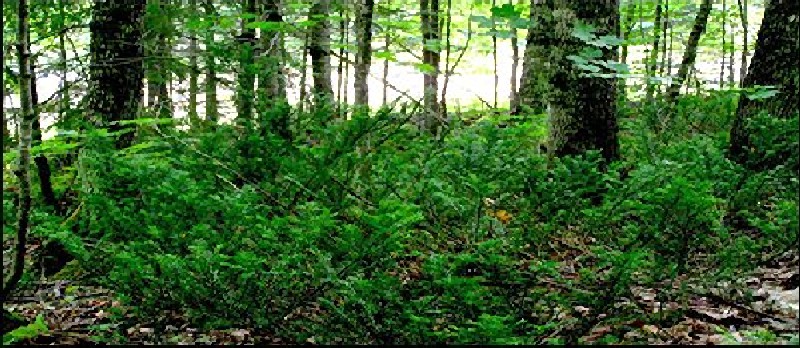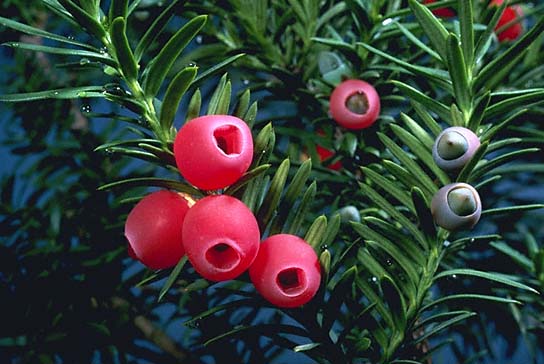|
 |
|
Home Page
More News |
In Da Woods
by Melanie B. Fullman, US Forest
Service
|
 |
Here’s Looking
at Yew
A gentleman from
Bessemer recently called to ask what I
knew about the increasing scarcity of
“ground hemlock”? He said he frequently
walks along the Black River near
Bessemer and used to see lots of ground
hemlock, even avoiding it wherever
possible because “the 6-8’ ground
branches impeded walking”. He stated it
is definitely NOT a tree, more
shrub-like.
I was confused. Ground
hemlock??? So I consulted the Oracle -
Forest Botanist Sue Trull, who quickly
surmised he was referring to Canada yew
(Taxus Canadensis).
Yew There?
Canada yew is a low, straggling,
evergreen shrub typically 3-6' tall with
spreading limbs that be twice as wide as
the overall height. Short, flat needles
are dark green above, pale green below,
becoming a reddish-brown in winter. The
brown bark is thin and scaly.
The shrub lives in moist, mixed woods
from Newfoundland to southeastern
Manitoba and south through the
northeastern and central US, including
the North Woods. It thrives in swampy
forests, ravines, riverbanks, and on
lake shores. It some places it is simply
called "yew"; in other parts, American
yew or ground-hemlock.
Like other
yews, it is highly shade-tolerant, with
clumps of the plants often forming a
fairly continuous, dense ground cover.
Interestingly, the creation of a dense
yew covering appears to prevent the
establishment of
balsam fir. Canada yew does not live
at all in open, well-light communities
like aspen stands. It is also highly
intolerant of disturbance, readily
extirpated by logging or fire.
Regeneration by seed is primarily from
the droppings of birds perched in older
forests.
Highly preferred by
moose and white-tailed deer, it can be
easily eaten out of an area. Its
widespread decline in Wisconsin and the
UP, including the Bessemer area, is
probably due to excessive deer browsing.
|
 |
|
Yew-Turn
Canada yew berries are small, fleshy,
and bright red. While that’s makes an
easy meal for several species of birds –
namely grouse, cedar waxwings, and
robins – the attractiveness of the
fruits is generally bad news for
parents. Most parts of the yew are
poisonous to humans, horses, and cattle.
Sensitivity to the toxin varies by age,
weight, physical condition, and
individual susceptibility. Children are
most vulnerable because of their
curiosity and small size. Toxicity can
also vary in a particular plant, by
season, the plant parts, and its stage
of growth.
In an odd twist of
nature, this toxin that can sicken
people unintentionally can also save
lives. In 1960, the USDA and National
Cancer Institute started testing plants
for chemicals that might have the
potential to fight cancer. A compound
called paclitaxel was identified as an
anti-cancer chemical in the bark of
Pacific yew shrubs. Unfortunately, the
demand for the chemical was greater than
the supply of Pacific yew. And it has
proven quite difficult to produce by
synthetic means.
Enter the Canada
yew, a close relative of, and much more
abundant species than the Pacific. Plus,
the critical taxane compound can be
obtained from new shoots of Canada yew
branches on a 5-year cycle, whereas it
must be stripped from the bark of the
Pacific variety, which kills the plant.
Given the high levels of taxanes in
Canada yew, this species is poised to
become one of the most valuable natural
sources of taxane for the pharmaceutical
industry.
No
More Taxus? (sorry, couldn’t
resist)
Not surprisingly, commercial
yew harvest has increased dramatically
in Canada and the US in the last 20
years. Both the European Union and US
Food and Drug Agency require that all
plants used for drug production be
harvested in a sustainable manner. An
audit of some harvesters in Ontario
concluded they were using sustainable
harvest practices, but the regulations
are difficult to enforce.
Given its
susceptibility to disturbance and browse
pressure, it will be critical to ensure
that wild Canada yew populations remain
healthy, for the sake of the forest and
us!
Like I always say, hoping to
see YEW in the woods.
[OK, you
can stop groaning now at the awful puns!
J ]
|
|
| |
| |
| |
| |

Polar Bear
Cookbook
Thank you
to everyone who submitted
recipes for the Polar Bear
Hockey Cookbook. The cookbooks
are now available. The cost for
the cookbooks are $10.00 so make
sure to grab one for yourself
and maybe one or two as a gift.
They can be purchased at the Pat
O'Donnel Civic Center concession
stand or by contacting Kerry
Roehm or Micki Sorensen. |
|
|